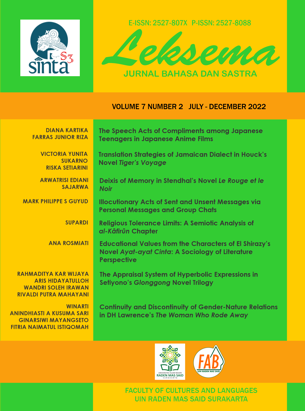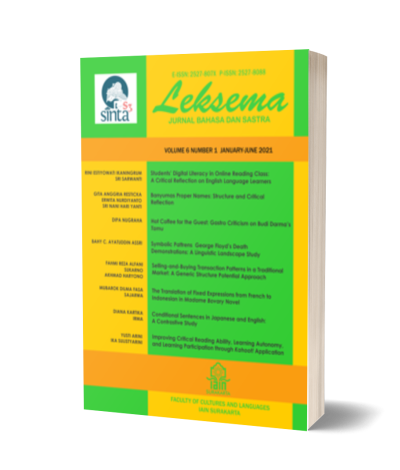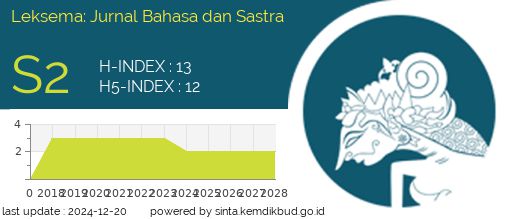DEIXES OF MEMORY IN STENDHAL'S NOVEL 'LE ROUGE ET LE NOIR'
DOI:
https://doi.org/10.22515/ljbs.v7i2.5499Keywords:
deixes of memory, demonstratives, referentsAbstract
Contexts in the identification of referents can be developed from external reality to cognitive reality or memory marked by the French demonstrative determinants ce, cet, cette, and ces as deixes of memory. Information in memory deixis referents can be categorized into the different statuses of information for the hearer, i.e. new information and old information. This study employed the qualitative-descriptive method with the data obtained from the novel Le Rouge et le Noir (1830) written by Stendhal. The study’s findings show that memory deixis referents can be identified through the way they evoke the readers’ old memories or (2) evoke the speakers’ memories and provide new information to the reader. In addition, deixes of memory can be demonstrative and performative. They may be used to describe the social life in 19th century France, to show the speakers’ emotional states, or to introduce a new topic in the text.
Downloads
References
Adamson, Sylvia. 2006. “Deixis and the Renaissance Art of Self Construction.” Sederi Yearbook 16: 5-29
Ashsyuhada, Juhal. 2018. Deiksis Empati Referen Demonstratif This dan That pada Film The Fault In Our Stars (Thesis) Bandung: Universitas Komputer Indonesia
Biquard, Claire. 1993. “Piété et Foi Dans Le Faubourg Saint-Germain au XIXe Siècle.” Histoire, Économie et Société 12 (2): 299-318. http://www.jstor.org/stable/23611408
Bordas, Éric. 2001. “Un Stylème Dix-Neuviémiste : Le Déterminant Discontinu Un de Ces...Qui...” L Information Grammaticale 90 (1): 32-43. https://doi.org/10.3406/igram.2001.2699
Chafe, Wallace L. 1976. “Givenness, Contrastiveness, Definiteness, Subjects, Topics, and Point of View in Subject and Topic.” In Charles Li (ed.). Symposium on Subject and Topic: 25-55. New York: Academic Press
Clark, Herbert H. 1996. Using Language. Cambridge: Cambridge University Press.
Compton, R Andrew. 2017. “Deixis Variation as a Literary Device in Ezekie: Utilizing an Act of Neglected Linguistic Feature in Exegesis.” Mid-America Journal of Theology 28: 77-107
Dama, Idrus. 2020. Memori, Trauma, dan Respon Terhadap Peristiwa Traumatis dalam Novel Never Let Me Go Karya Kazuo Ishiguro (S2 Thesis). Yogyakarta: Universitas Gadjah Mada
Diessel, Holger. 1999. Demonstratives: Form, Function, and Grammaticalization. Amsterdam: John Benjamins Publishing
Dubois, Jean, and Rene Lagane. 2001. Grammaire. Paris: Larousse
Eagle, Christopher. 2006. “On ‘This’ and ‘That’ in Proust: Deixis and Typologies in À La Recherche Du Temps Perdu.” MLN 121 (4): 989-1008
Garrioch, David. 2007. “La Bourgeoisie Parisienne au Début du XIXe Siècle: Le Cas du Faubourg Saint-Marcel.” Revue d’Histoire du XIXe Siècle 34 (June): 39-53. https://doi.org/10.4000/rh19.1282
Gundel, Jeanette K. 1974. “The Role of Topic and Comment in Linguistic Theory”. Austin: University of Texas
Hargreaves, Alec G. 1989. “Presence and Distance in Travel Literature Deixis in Pierre Loti’s Les Pagodes d’Or”. Romance Studies 7 (2): 53-61. https://doi.org/10.1179/026399090786621048
Himmelmann, Nikolaus P. 1996. “Demonstratives in Narrative Discourse.” In Barbara A Fox (ed.). Studies in Anaphora. https://doi.org/10.1075/tsl.33.08him
Khachaturyan, Maria. 2019. “Knowing Is Belonging: Recognitional Deixis and Emergence of Common Ground in Religious Conversion.” Signs and Society 7 (2): 186-216. https://doi.org/10.1086/702441
Kuno, Susumo. 1972. “Functional Sentence Perspective: A Case Study from Japanese and English.” Linguistic Inquiry 3 (3): 269-320
Maingueneau, Dominique. 2005. Linguistique Pour Le Texte Littéraire. Paris: Armand Colin
Maza, Sarah. 2007. “Construire et Déconstruire La Bourgeoisie : Discours Politique et Imaginaire Social au Début du XIXe Siècle.” Revue d’Histoire du XIXe Siècle34 (June): 21-37. https://doi.org/10.4000/rh19.1262
Muhyidin, Asep. 2019. “Deiksis Dalam Novel Daun yang Jatuh Tak Pernah Membenci Angin Karya Tere Liye dan Skenario Pembelajarannya di SMA”. Metalingua 17 (1): 45-46
Nanto, Nanto, Andi Haris Prabawa & Laili Etika Rahmawati. 2015. Deiksis dalam Teks Anekdot Pada Media Massa Koran Solopos Edisi September sampai November Tahun 2014. Surakarta: Universitas Muhammadiyah Surakarta
Nurrachman, Nani IR. 2016. “Dari Memori Menjadi Narasi: Trauma Sosial dalam Sejarah Nasional.” Jurnal HAM 8
Nuryadin, Sulandri. 2017. “Educational Values in Roman: Le Rouge et le Noir/The Red and the Black and the Chartreuse of Parma Written by Stendhal”. International Journal of Language Education and Culture Review (IJLECR) 3 (1): 35-48. https://doi.org/10.21009/IJLECR.031.05
Paveau, Marie-Anne. 2006. “Chapitre 6. Mondes Partagés”. In Les Prédiscours: Sens, Mémoire, Cognition: 173-86. Sorbonne: Presses Sorbonne Nouvelle. http://books.openedition.org/psn/738
Pettazzoni, Raffaele. 1955. “L’Esprit Du Paganisme.” Diogène 9: 3
Rahayu, Anisa Dwi, and Maria Mintowati. 2019. “Bentuk dan Fungsi Sosial Deiksis dalam Film 不能说的秘密 karya 周杰伦 (Jay Chou)”. Jurnal Cakrawala Mandarin 2 (2): 17. https://doi.org/10.36279/apsmi.v2i2.63
Rühlemann, Christoph & Matthew Brook O’Donnell. 2014. “Deixis.” In Karin Aijmer & Christoph Rühlemann (eds.). Corpus Pragmatics: 331-359. Cambridge: Cambridge University Press. https://doi.org/10.1017/CBO9781139057493.018
Sajarwa. 2000. “Status Informasi dalam Kalimat dan Wacana Bahasa Prancis.” Humaniora 12 (3): 279-284
Skilton, Amalia E. 2019. “Spatial and Non-Spatial Deixis in Cushillococha Ticuna.” Berkeley: University of California https://escholarship.org/content/qt50w177t6/qt50w177t6_noSplash_d979340ab3d170a9f5ac9c17c2f9b6a5.pdf?t=psqmac.
Spenader, Jennifer. 2003. “Factive Presuppositions, Accommodation and Information Structure.” Journal of Logic, Language and Information 12 (3).
Videlier, Philippe. 1986. Les Italiens de La Région Lyonnaise. Sous La Direction de Pierre Milza. https://www.persee.fr/doc/efr_0000-0000_1986_mon_94_1_3174.
Wijaya, David Kurnia. 2000. “Representasi Nilai Kebaharian dalam Novel Mata dan Manusia Laut Karya Okky Madasari: Perspektif Memori Kolektif.” Bapala 7 (2)
Downloads
Published
Issue
Section
License
Copyright (c) 2022 Leksema: Jurnal Bahasa dan Sastra

This work is licensed under a Creative Commons Attribution-NonCommercial-ShareAlike 4.0 International License.
The copyright of the received article shall be assigned to the publisher of the journal. The intended copyright includes the right to publish the article in various forms (including reprints). The journal maintains the publishing rights to published articles.
In line with the license, the authors and users (readers or other researchers) are allowed to share and adapt the material only for non-commercial purposes. In addition, the material must be given appropriate credit, provided with a link to the license, and indicated if changes were made. If authors remix, transform or build upon the material, authors must distribute their contributions under the same license as the original.







